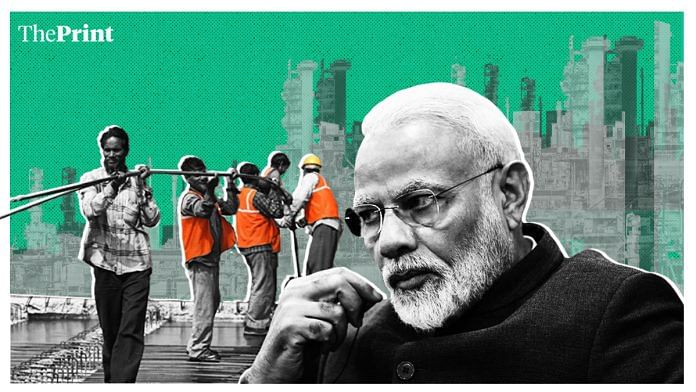A long-standing demand of investors has been to reform India’s outdated labour laws and do away with the ‘inspector raj’ system. This week, PM Narendra Modi’s government began an overhaul by introducing two labour code bills in the Lok Sabha. The Code on Wages Bill will subsume four existing labour laws. The Code on Occupational Safety, Health and Working Conditions Bill will incorporate 13 older laws.
ThePrint asks: Do Modi govt’s labour code amendments hurt worker rights or are they good for industry?
Labour code reforms excellent – will dramatically cut red tape
 Gurcharan Das
Gurcharan Das
Author and former CEO of Procter & Gamble India
The labour code amendments are an excellent step forward. Having one license, one registration (instead of 10), and one return will dramatically cut red tape, which is the real curse in an entrepreneur’s life.
By having every form online, the entrepreneur will hopefully not have to see the evil face of the dreaded corrupt labour inspector. Not allowing inspectors to visit an entrepreneur except when the computer picks up an anomaly is theoretically a good idea. It has been in practice in the income tax department for some time, but citizens have reported that in practice officers and inspectors find a way to get around it.
I am also pleased that the proposed code will reduce the number of labour code provisions from 622 to 134, as this will certainly help in bringing simplicity and make compliance easier. If India can cut the evils of ‘inspector raj’, it will certainly improve the Ease of Doing Business rankings and make the nation more competitive.
We should not be too hung up with labour rights because the existing laws have created a labour aristocracy, which has harmed the interests of more than 90 per cent of Indian labourers by discouraging employers from hiring new people.
Ultimately, we have to join the rest of the world in making our labour laws flexible and consistent.
Also read: Modi govt’s new labour bills pro-employer or employee? Truth lies in between: Ex-IAS officer
Modi govt’s new labour bills aimed more at climbing Ease of Doing Business index than any real reform
 Narendar Pani
Narendar Pani
Professor, National Institute of Advanced Studies
The Modi government’s new labour code reforms appear to be designed more to climb up the Ease of Doing Business index rather than making a substantial difference on ground.
The main thrust of the code is its simplification in terms of the number of agencies involved in monitoring aspects of labour relations. The substantial reduction in the agencies will bring down the number of bureaucratic hurdles to be crossed when setting up large industries. There is also an effort to present the picture of a new hire-and-fire regime by increasing the size of the firm above which one would have to take the permission of the government to lay-off or retrench workers. It has gone from 100 workers to 300. But when we move from the optics to conditions on the ground, the reforms are far less dramatic. Most large companies would be beyond the threshold set for the hire-and-fire regime.
Getting informal workers under the same net as formal employees in large companies is also much easier said than done. The government does not have the mechanism to enforce its labour laws on units employing informal workers across the country. The provisions of the code that would have a direct effect on labour are surprisingly weak, with the proposed national floor wage not being very much above the existing minimum wage.
Also read: To get more women in labour force, India must stop pushing industrial areas to city limits
Pitching the good of employees over that of industries as an objective is a misplaced idea
 Rituparna Chakraborty
Rituparna Chakraborty
Co-Founder, TeamLease Services Ltd.
A $5-trillion economy can happen by putting India to work — formal work, to be precise. So the four labour categories (which will comprise 44 labour laws) should not be viewed through the lense of perfection but as progress. Progress from the unpaid dues on labour accumulated over six decades.
According to OECD, India has been the most regulated labour market but the least protective. Also, job preservation as a theme for labour laws is far from protection of the vast majority that is unable to shift to the formal workforce. Therefore, to pitch what is good for employees as a contrary objective to what is good for industries seems to be a misplaced idea.
Simplification, rationalisation, digitalisation of our labour markets will help the government acquire enhanced ability to supervise and regulate. It will help the employers reduce the cost of compliance, making them more competitive, and help expand their businesses towards creating more formal jobs. It will also help the country’s youth by providing them with more options to earn livelihoods of dignity.
Creating a sense of perfection around the four labour codes (wages, industrial relations, social security, and industrial safety & welfare) would amount to having a single labour code. But let’s leave it for the next wave of labour reform.
Universal minimum wage remarkable, if not revolutionary. But does Modi govt have machinery to carry it out?
 K.R. Shyam Sundar
K.R. Shyam Sundar
Professor at XLRI – Xavier School of Management
While it is necessary to rationalise the numerous labour laws into collapsible codes, whether the Modi government’s labour code amendments hurt workers’ rights or are good for the industry cannot be answered in black and white – they are a mixed bag.
The exercise of codification of labour laws is extremely welcome, because the definition of terms such as ‘workmen’ and ‘wages’ are ironed out. However, the process of codification under the Modi government is fairly wanting. This is because there was no bipartite or tripartite consultation with the stakeholders such as trade union organisations, and whatever consultation did take place was piecemeal, halting and partial.
The drafting process should have been done by retired juries, as it is evident from the language and structure that it is not a technician’s work. It seems that the Modi government is in a hurry to assuage the feelings of investors through the labour code amendments and want to send out a message to foreign investors that they are willing to carry out reforms. It is also important to note that the wage code is a huge failure in addressing gender-based discrimination at the workplace.
There are very remarkable declarations of universalising minimum wages and social security, which is a welcome step, in fact, it is revolutionary. However, the million-dollar question is whether the government has the enforcement machinery to carry out this process. How it will make this dream a reality and is this a symbolic declaration, or it can truly be actualised?
New amendments to labour code bills render compliance authorities toothless
 Ritesh Sharma
Ritesh Sharma
Labour rights lawyer
Easing business is the need of the hour in India. But when such reforms favouring employers come at the cost of reduced labour compliances, then there is a problem. The recent efforts of the Modi government to amalgamate and simplify labour laws have merits, but it also makes compliance authorities toothless.
The glaring provision that needs attention is sub-section 5 of Section 51 of the new wage code bill. This is because the compliance levels have been reduced and the labour inspector is now merely a ‘facilitator’. It is important to understand that when labour laws are simplified, it helps employers, not labourers. This subsection gives discretion to the inspector-cum-facilitator to negotiate between workers and employers if there is a grievance. The clause is fairly problematic as it allows the ‘facilitator’ the choice to not get involved in a dispute. Further sub-section 3 of Section 54 has a ‘non-obstante clause’ wherein the inspector-cum-facilitator must give an opportunity to the employer to comply with the provisions of the code before initiating any prosecution. It is a mandatory provision, and can be translated as more room for employers at the cost of labourers’ basic and essential needs including wages, health and safety ecosystem.
Another provision that requires attention is Section 64 of the wage code bill, which has been taken from the Madhya Pradesh state amendment of the Minimum Wage Act 1948. It states that the non-payment of minimum wages won’t result in attachment of employers’ property. Earlier, if an employer did not pay wages to his/her labourers, their factory could be seized. This has now been repealed. Such a move will surely affect the payment of wages to labourers.
By Revathi Krishnan







One simple reform would be to allow the use of contract labour for manufacturing / principal operations. That would give managements the required flexibility to change the size of the work force, responding to market conditions.